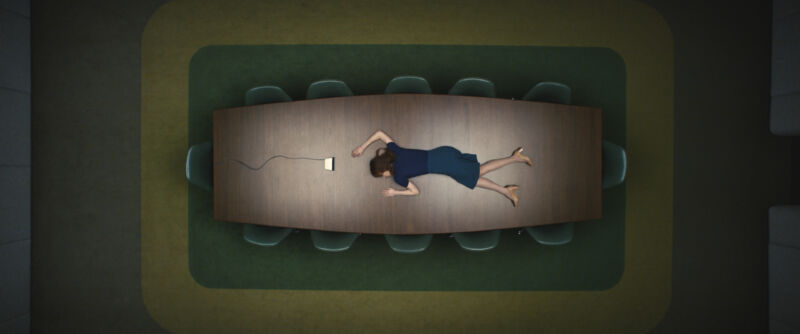Why Severance is one of the best shows on TV

Severance, which recently completed its first-season run on Apple TV+, explores a world in which people can really separate their work and personal lives. Thanks to a new procedure developed by Lumon Industries, people can bifurcate themselves into “innies” (work selves) and “outies” (personal selves)—with no sharing of memories. This appeals to people like Mark, who lost his wife in a car crash and has struggled to work through the grief. Why not forget all that pain for eight hours a day?
Mark works on the “severed floor” at Lumon, a place that makes your own office—no matter how bad it is—look like Disney World. But Mark likes it. Or thinks he likes it. Meanwhile, we as viewers have a few concerns. What, for instance, is he actually doing all day for Lumon? What’s with the creepy cult-like vibe everywhere? What happened to his buddy Petey? And why are people so excited about waffle parties?
If you think this sounds like the setup for a corporate sci-fi dystopia, you’re not wrong. Severance makes terrific TV out of its premise. Directed by Ben Stiller, the show is funny, absurd, depressing, mysterious, visually distinct, and ultimately propulsive. Each episode gathers speed, from the slow start to the rip-roarin’ finale, making this one of the best things we’ve seen so far in 2022. Here’s why.
(Some minor spoilers below)
Beauty amid the banality
Severance pulls off a nifty trick: turning windowless offices, fluorescent lighting, corporate furniture, break rooms, staircases, elevators, and antiseptic white corridors into something that goes from banal to menacing to—dare I say it?—wondrous.
The banality is clear enough. Lumon workers are encouraged with ridiculous corporate “perks” like finger traps and waffle parties, even as they work in absurdly empty spaces. The workers answer to middle managers who never seem fully human, even when asking people to show “kind eyes” to others. And the food coming out of the vending machine—shriveled raisins, anyone?—is unappetizing at best. The team’s collective work might be “mysterious and important,” as one character puts it, but this is an article of faith. To the viewer, the work looks like tedium.
Then comes the menace layered atop the banality. We meet Helly R. in a normal conference room—but one where she is locked in, sprawled out on the table, and talked to by a disembodied voice. We hear hints of violence between the departments and are treated to odd, cult-like sayings from “the Handbook.” A character suffers disturbing hallucinations. A paper cutter is repurposed as a threatening weapon. The company has a mysterious scheme to do… something. The break room is a really bad place to be. So Severance takes its place in a long line of corporate dystopias.
But among the menace, we also feel an increasing sense of wonder. The labyrinthine basement is a maze that Lumon has forbidden its employees to map. Why? We don’t know. But we do follow our team of lovable Lumon losers as they, like growing toddlers, stray further than their guardians allow. Our team discovers new things. They find other departments, with the hint of many more waiting to be revealed. They explore a bizarre Perpetuity Wing. They find some, err, small bottle-fed quadrupeds (not to be too spoiler-y). Lumon might be creepy, but its people still respond to beauty when they find it, as Burt and Irving do in the Plant Room.
Among all the maze-like mystery, our team begins to make connections—between departments, between inner and outer selves, between each other. People grow, thanks in part to a ridiculous self-help book that makes it onto the severed floor. Families, lovers, and children become increasingly important.
Severance is an office parody. It is a tale of corporate dystopia and evil schemes. But it is also a show about healing, empathy, new life, and emotional growth under unpromising conditions. Holding all of these elements together gives the show its peculiar impact.
—Nate Anderson, Deputy Editor
https://arstechnica.com/?p=1852550